Manufacturing Technology: Overview, Adoption, and Competitive Analysis
VerifiedAdded on 2021/09/19
|19
|4461
|179
Report
AI Summary
This report delves into the realm of manufacturing technology, exploring its significance and the reasons for its adoption by companies. It highlights how advanced manufacturing technologies, including computer-aided design (CAD), computer-aided manufacturing (CAM), and computer-integrated manufacturing (CIM), enable businesses to compete effectively across various dimensions such as design, manufacturing, and distribution. The report discusses the impact of these technologies on manufacturing processes and overall operations, emphasizing their role in achieving competitive advantages. It examines the integration of manufacturing technologies in different companies, identifies relevant technologies, and evaluates their operational aspects. The report also addresses the challenges faced in implementing these technologies, particularly in the context of the Chinese manufacturing sector, and provides insights into the benefits of automation, such as reduced labor costs, improved product quality, and expanded product capabilities. The research methodology includes qualitative research methods like interviews and questionnaires, to understand the current practices and technological flexibility of manufacturing industries.
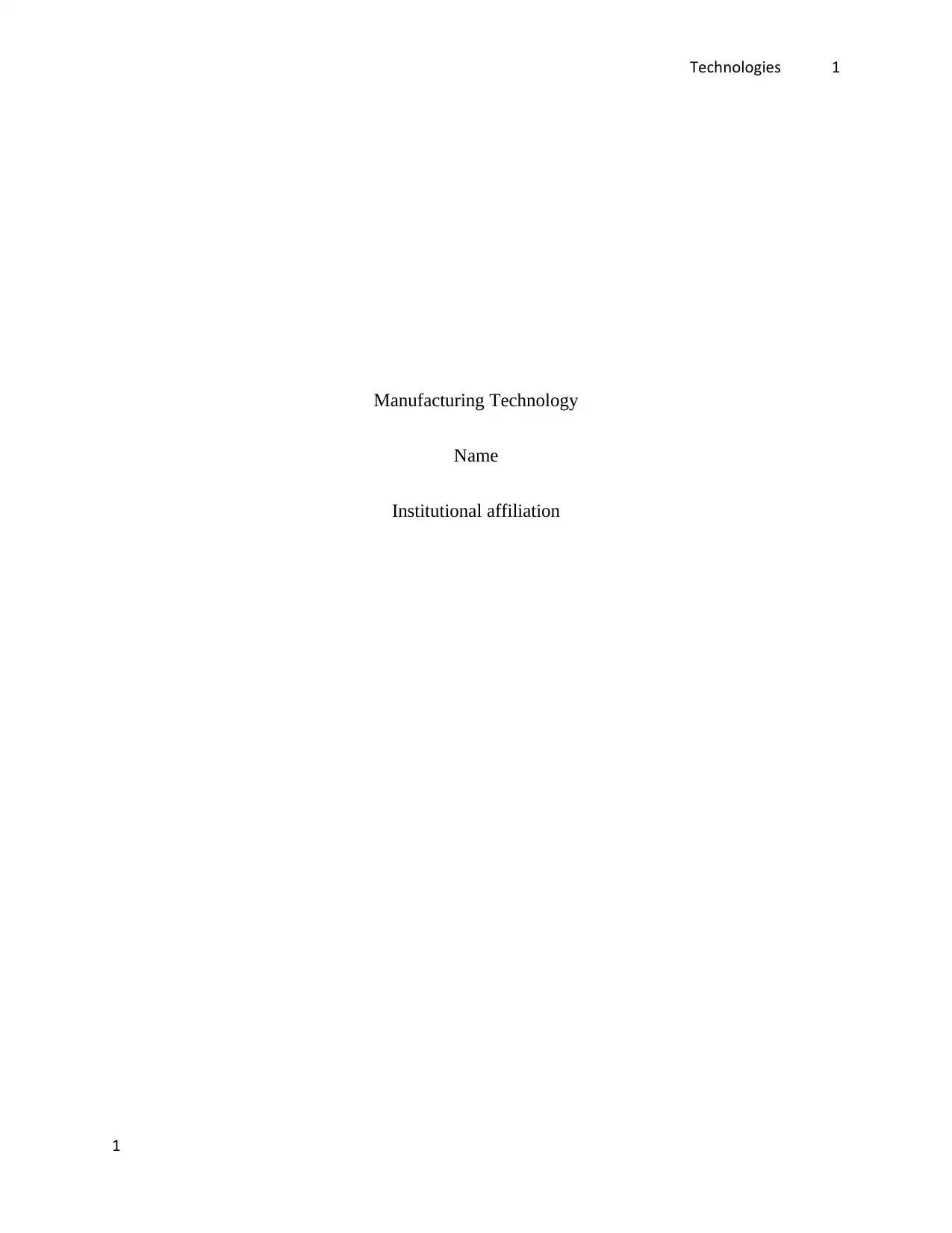
Technologies 1
Manufacturing Technology
Name
Institutional affiliation
1
Manufacturing Technology
Name
Institutional affiliation
1
Paraphrase This Document
Need a fresh take? Get an instant paraphrase of this document with our AI Paraphraser
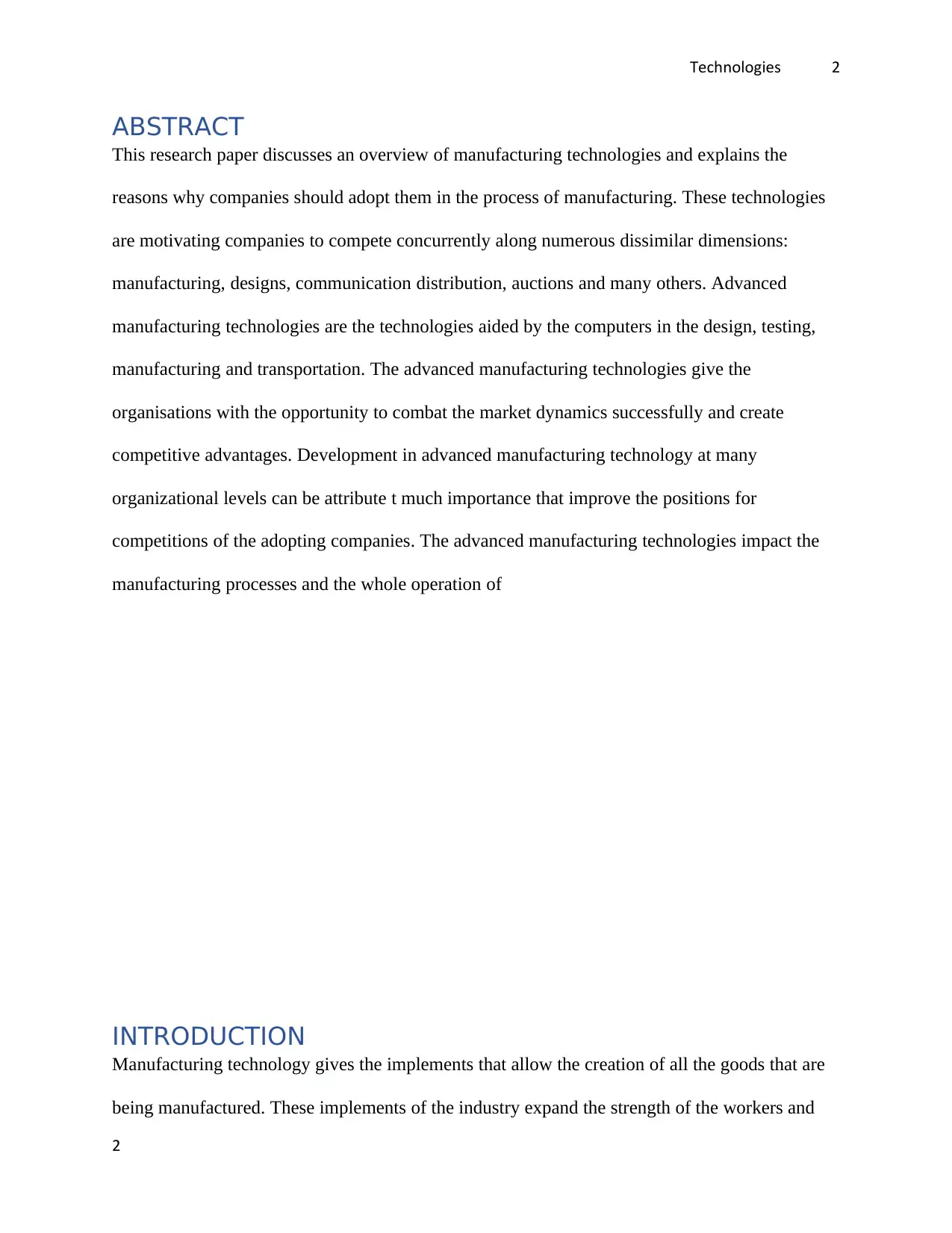
Technologies 2
ABSTRACT
This research paper discusses an overview of manufacturing technologies and explains the
reasons why companies should adopt them in the process of manufacturing. These technologies
are motivating companies to compete concurrently along numerous dissimilar dimensions:
manufacturing, designs, communication distribution, auctions and many others. Advanced
manufacturing technologies are the technologies aided by the computers in the design, testing,
manufacturing and transportation. The advanced manufacturing technologies give the
organisations with the opportunity to combat the market dynamics successfully and create
competitive advantages. Development in advanced manufacturing technology at many
organizational levels can be attribute t much importance that improve the positions for
competitions of the adopting companies. The advanced manufacturing technologies impact the
manufacturing processes and the whole operation of
INTRODUCTION
Manufacturing technology gives the implements that allow the creation of all the goods that are
being manufactured. These implements of the industry expand the strength of the workers and
2
ABSTRACT
This research paper discusses an overview of manufacturing technologies and explains the
reasons why companies should adopt them in the process of manufacturing. These technologies
are motivating companies to compete concurrently along numerous dissimilar dimensions:
manufacturing, designs, communication distribution, auctions and many others. Advanced
manufacturing technologies are the technologies aided by the computers in the design, testing,
manufacturing and transportation. The advanced manufacturing technologies give the
organisations with the opportunity to combat the market dynamics successfully and create
competitive advantages. Development in advanced manufacturing technology at many
organizational levels can be attribute t much importance that improve the positions for
competitions of the adopting companies. The advanced manufacturing technologies impact the
manufacturing processes and the whole operation of
INTRODUCTION
Manufacturing technology gives the implements that allow the creation of all the goods that are
being manufactured. These implements of the industry expand the strength of the workers and
2
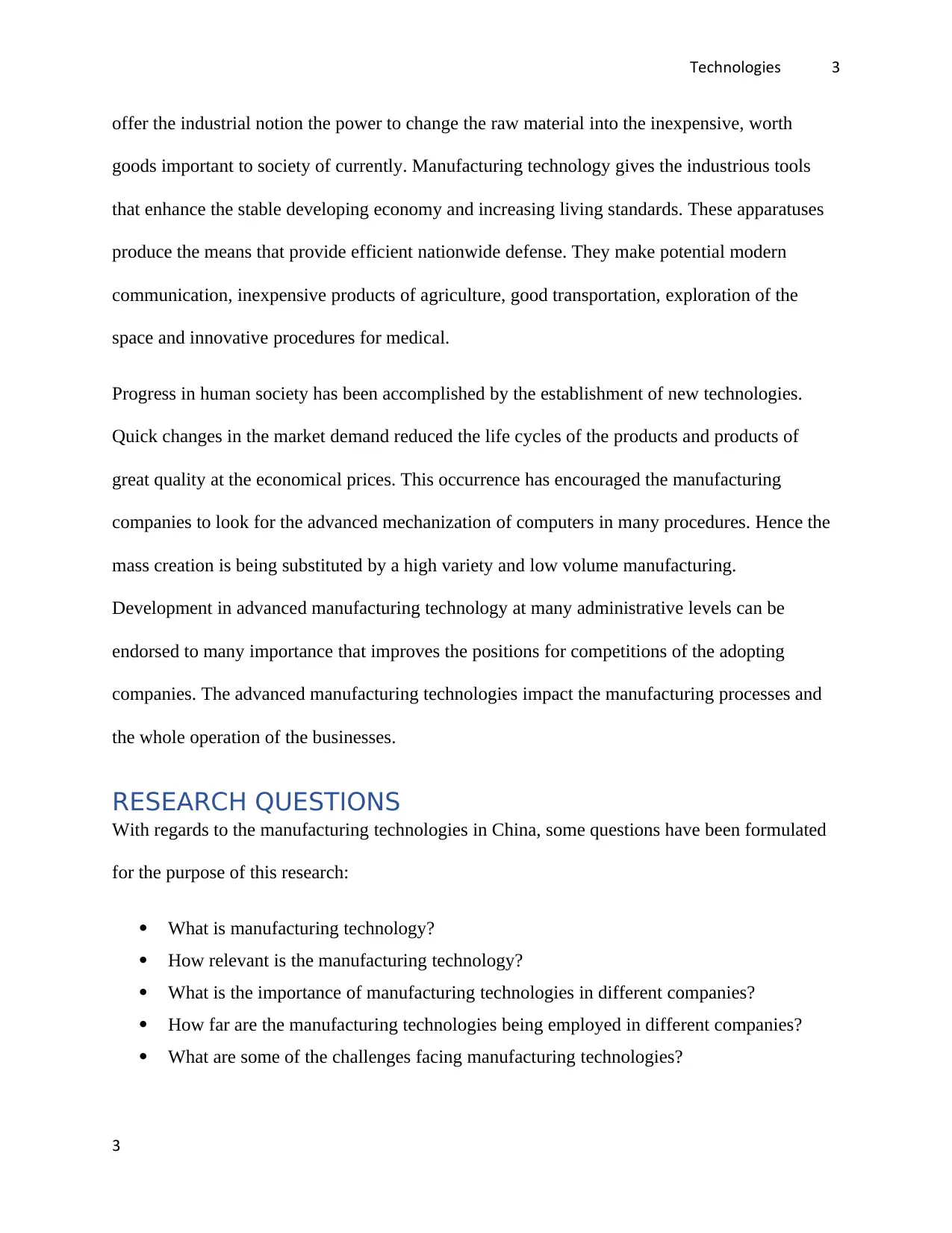
Technologies 3
offer the industrial notion the power to change the raw material into the inexpensive, worth
goods important to society of currently. Manufacturing technology gives the industrious tools
that enhance the stable developing economy and increasing living standards. These apparatuses
produce the means that provide efficient nationwide defense. They make potential modern
communication, inexpensive products of agriculture, good transportation, exploration of the
space and innovative procedures for medical.
Progress in human society has been accomplished by the establishment of new technologies.
Quick changes in the market demand reduced the life cycles of the products and products of
great quality at the economical prices. This occurrence has encouraged the manufacturing
companies to look for the advanced mechanization of computers in many procedures. Hence the
mass creation is being substituted by a high variety and low volume manufacturing.
Development in advanced manufacturing technology at many administrative levels can be
endorsed to many importance that improves the positions for competitions of the adopting
companies. The advanced manufacturing technologies impact the manufacturing processes and
the whole operation of the businesses.
RESEARCH QUESTIONS
With regards to the manufacturing technologies in China, some questions have been formulated
for the purpose of this research:
What is manufacturing technology?
How relevant is the manufacturing technology?
What is the importance of manufacturing technologies in different companies?
How far are the manufacturing technologies being employed in different companies?
What are some of the challenges facing manufacturing technologies?
3
offer the industrial notion the power to change the raw material into the inexpensive, worth
goods important to society of currently. Manufacturing technology gives the industrious tools
that enhance the stable developing economy and increasing living standards. These apparatuses
produce the means that provide efficient nationwide defense. They make potential modern
communication, inexpensive products of agriculture, good transportation, exploration of the
space and innovative procedures for medical.
Progress in human society has been accomplished by the establishment of new technologies.
Quick changes in the market demand reduced the life cycles of the products and products of
great quality at the economical prices. This occurrence has encouraged the manufacturing
companies to look for the advanced mechanization of computers in many procedures. Hence the
mass creation is being substituted by a high variety and low volume manufacturing.
Development in advanced manufacturing technology at many administrative levels can be
endorsed to many importance that improves the positions for competitions of the adopting
companies. The advanced manufacturing technologies impact the manufacturing processes and
the whole operation of the businesses.
RESEARCH QUESTIONS
With regards to the manufacturing technologies in China, some questions have been formulated
for the purpose of this research:
What is manufacturing technology?
How relevant is the manufacturing technology?
What is the importance of manufacturing technologies in different companies?
How far are the manufacturing technologies being employed in different companies?
What are some of the challenges facing manufacturing technologies?
3
⊘ This is a preview!⊘
Do you want full access?
Subscribe today to unlock all pages.

Trusted by 1+ million students worldwide
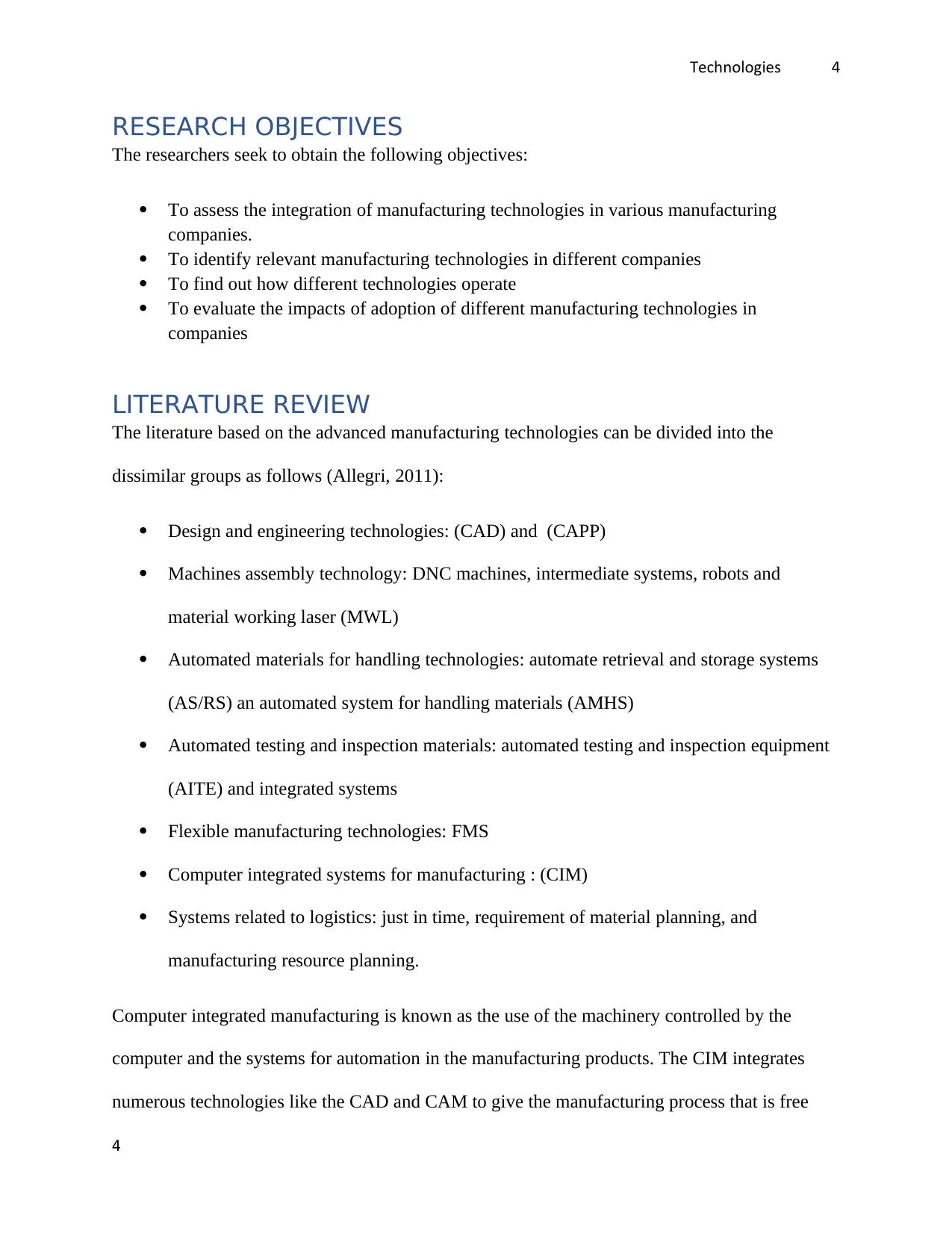
Technologies 4
RESEARCH OBJECTIVES
The researchers seek to obtain the following objectives:
To assess the integration of manufacturing technologies in various manufacturing
companies.
To identify relevant manufacturing technologies in different companies
To find out how different technologies operate
To evaluate the impacts of adoption of different manufacturing technologies in
companies
LITERATURE REVIEW
The literature based on the advanced manufacturing technologies can be divided into the
dissimilar groups as follows (Allegri, 2011):
Design and engineering technologies: (CAD) and (CAPP)
Machines assembly technology: DNC machines, intermediate systems, robots and
material working laser (MWL)
Automated materials for handling technologies: automate retrieval and storage systems
(AS/RS) an automated system for handling materials (AMHS)
Automated testing and inspection materials: automated testing and inspection equipment
(AITE) and integrated systems
Flexible manufacturing technologies: FMS
Computer integrated systems for manufacturing : (CIM)
Systems related to logistics: just in time, requirement of material planning, and
manufacturing resource planning.
Computer integrated manufacturing is known as the use of the machinery controlled by the
computer and the systems for automation in the manufacturing products. The CIM integrates
numerous technologies like the CAD and CAM to give the manufacturing process that is free
4
RESEARCH OBJECTIVES
The researchers seek to obtain the following objectives:
To assess the integration of manufacturing technologies in various manufacturing
companies.
To identify relevant manufacturing technologies in different companies
To find out how different technologies operate
To evaluate the impacts of adoption of different manufacturing technologies in
companies
LITERATURE REVIEW
The literature based on the advanced manufacturing technologies can be divided into the
dissimilar groups as follows (Allegri, 2011):
Design and engineering technologies: (CAD) and (CAPP)
Machines assembly technology: DNC machines, intermediate systems, robots and
material working laser (MWL)
Automated materials for handling technologies: automate retrieval and storage systems
(AS/RS) an automated system for handling materials (AMHS)
Automated testing and inspection materials: automated testing and inspection equipment
(AITE) and integrated systems
Flexible manufacturing technologies: FMS
Computer integrated systems for manufacturing : (CIM)
Systems related to logistics: just in time, requirement of material planning, and
manufacturing resource planning.
Computer integrated manufacturing is known as the use of the machinery controlled by the
computer and the systems for automation in the manufacturing products. The CIM integrates
numerous technologies like the CAD and CAM to give the manufacturing process that is free
4
Paraphrase This Document
Need a fresh take? Get an instant paraphrase of this document with our AI Paraphraser
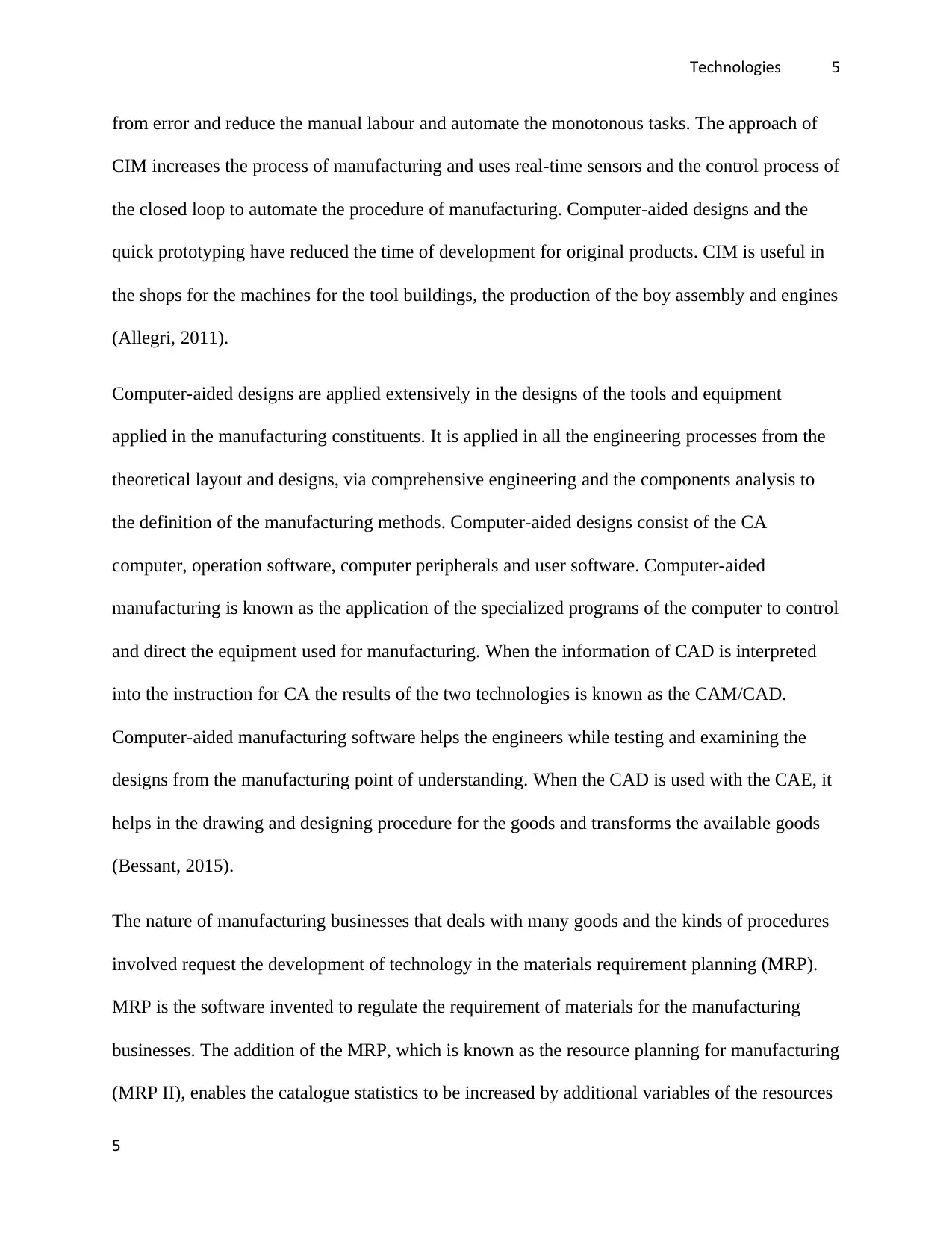
Technologies 5
from error and reduce the manual labour and automate the monotonous tasks. The approach of
CIM increases the process of manufacturing and uses real-time sensors and the control process of
the closed loop to automate the procedure of manufacturing. Computer-aided designs and the
quick prototyping have reduced the time of development for original products. CIM is useful in
the shops for the machines for the tool buildings, the production of the boy assembly and engines
(Allegri, 2011).
Computer-aided designs are applied extensively in the designs of the tools and equipment
applied in the manufacturing constituents. It is applied in all the engineering processes from the
theoretical layout and designs, via comprehensive engineering and the components analysis to
the definition of the manufacturing methods. Computer-aided designs consist of the CA
computer, operation software, computer peripherals and user software. Computer-aided
manufacturing is known as the application of the specialized programs of the computer to control
and direct the equipment used for manufacturing. When the information of CAD is interpreted
into the instruction for CA the results of the two technologies is known as the CAM/CAD.
Computer-aided manufacturing software helps the engineers while testing and examining the
designs from the manufacturing point of understanding. When the CAD is used with the CAE, it
helps in the drawing and designing procedure for the goods and transforms the available goods
(Bessant, 2015).
The nature of manufacturing businesses that deals with many goods and the kinds of procedures
involved request the development of technology in the materials requirement planning (MRP).
MRP is the software invented to regulate the requirement of materials for the manufacturing
businesses. The addition of the MRP, which is known as the resource planning for manufacturing
(MRP II), enables the catalogue statistics to be increased by additional variables of the resources
5
from error and reduce the manual labour and automate the monotonous tasks. The approach of
CIM increases the process of manufacturing and uses real-time sensors and the control process of
the closed loop to automate the procedure of manufacturing. Computer-aided designs and the
quick prototyping have reduced the time of development for original products. CIM is useful in
the shops for the machines for the tool buildings, the production of the boy assembly and engines
(Allegri, 2011).
Computer-aided designs are applied extensively in the designs of the tools and equipment
applied in the manufacturing constituents. It is applied in all the engineering processes from the
theoretical layout and designs, via comprehensive engineering and the components analysis to
the definition of the manufacturing methods. Computer-aided designs consist of the CA
computer, operation software, computer peripherals and user software. Computer-aided
manufacturing is known as the application of the specialized programs of the computer to control
and direct the equipment used for manufacturing. When the information of CAD is interpreted
into the instruction for CA the results of the two technologies is known as the CAM/CAD.
Computer-aided manufacturing software helps the engineers while testing and examining the
designs from the manufacturing point of understanding. When the CAD is used with the CAE, it
helps in the drawing and designing procedure for the goods and transforms the available goods
(Bessant, 2015).
The nature of manufacturing businesses that deals with many goods and the kinds of procedures
involved request the development of technology in the materials requirement planning (MRP).
MRP is the software invented to regulate the requirement of materials for the manufacturing
businesses. The addition of the MRP, which is known as the resource planning for manufacturing
(MRP II), enables the catalogue statistics to be increased by additional variables of the resources
5
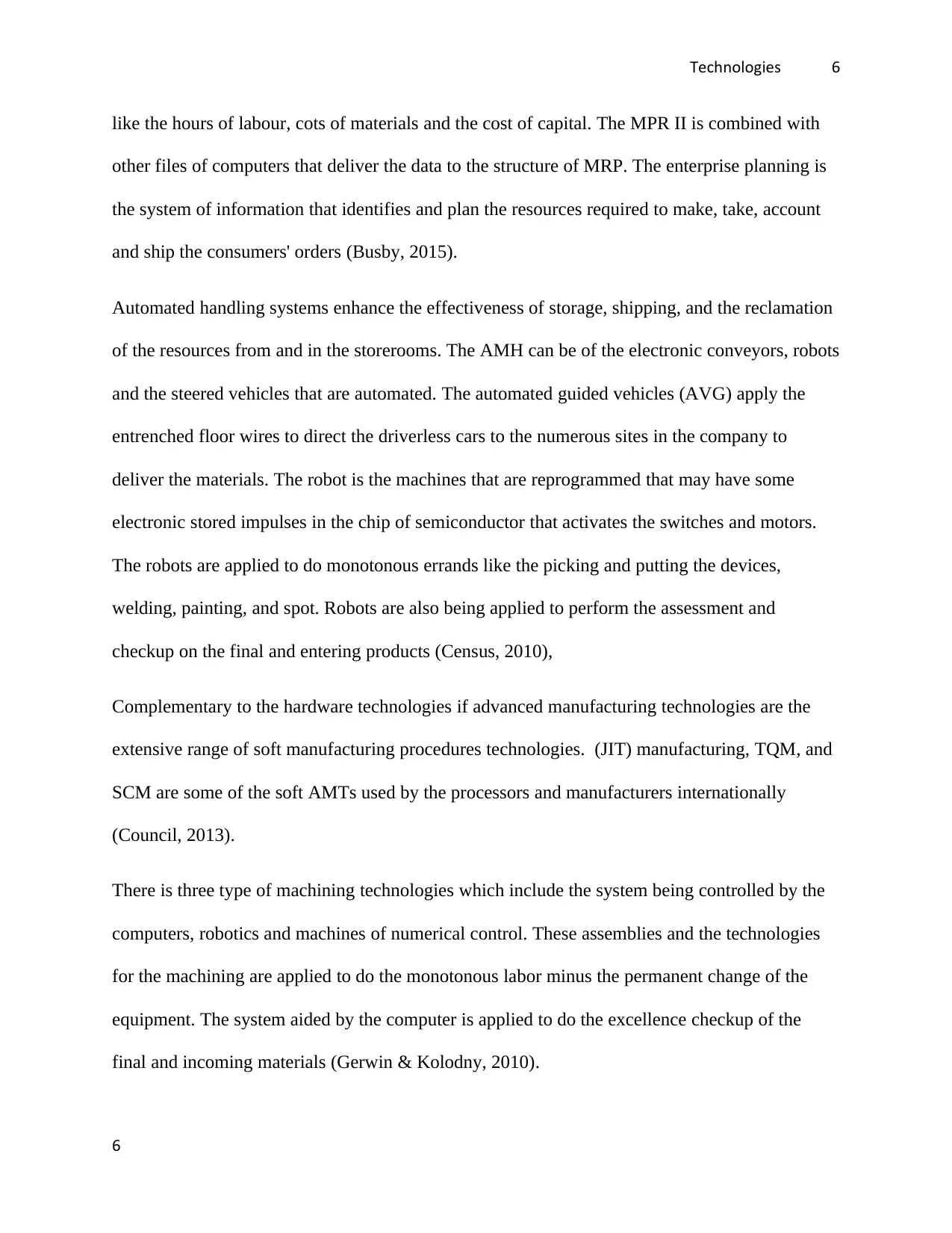
Technologies 6
like the hours of labour, cots of materials and the cost of capital. The MPR II is combined with
other files of computers that deliver the data to the structure of MRP. The enterprise planning is
the system of information that identifies and plan the resources required to make, take, account
and ship the consumers' orders (Busby, 2015).
Automated handling systems enhance the effectiveness of storage, shipping, and the reclamation
of the resources from and in the storerooms. The AMH can be of the electronic conveyors, robots
and the steered vehicles that are automated. The automated guided vehicles (AVG) apply the
entrenched floor wires to direct the driverless cars to the numerous sites in the company to
deliver the materials. The robot is the machines that are reprogrammed that may have some
electronic stored impulses in the chip of semiconductor that activates the switches and motors.
The robots are applied to do monotonous errands like the picking and putting the devices,
welding, painting, and spot. Robots are also being applied to perform the assessment and
checkup on the final and entering products (Census, 2010),
Complementary to the hardware technologies if advanced manufacturing technologies are the
extensive range of soft manufacturing procedures technologies. (JIT) manufacturing, TQM, and
SCM are some of the soft AMTs used by the processors and manufacturers internationally
(Council, 2013).
There is three type of machining technologies which include the system being controlled by the
computers, robotics and machines of numerical control. These assemblies and the technologies
for the machining are applied to do the monotonous labor minus the permanent change of the
equipment. The system aided by the computer is applied to do the excellence checkup of the
final and incoming materials (Gerwin & Kolodny, 2010).
6
like the hours of labour, cots of materials and the cost of capital. The MPR II is combined with
other files of computers that deliver the data to the structure of MRP. The enterprise planning is
the system of information that identifies and plan the resources required to make, take, account
and ship the consumers' orders (Busby, 2015).
Automated handling systems enhance the effectiveness of storage, shipping, and the reclamation
of the resources from and in the storerooms. The AMH can be of the electronic conveyors, robots
and the steered vehicles that are automated. The automated guided vehicles (AVG) apply the
entrenched floor wires to direct the driverless cars to the numerous sites in the company to
deliver the materials. The robot is the machines that are reprogrammed that may have some
electronic stored impulses in the chip of semiconductor that activates the switches and motors.
The robots are applied to do monotonous errands like the picking and putting the devices,
welding, painting, and spot. Robots are also being applied to perform the assessment and
checkup on the final and entering products (Census, 2010),
Complementary to the hardware technologies if advanced manufacturing technologies are the
extensive range of soft manufacturing procedures technologies. (JIT) manufacturing, TQM, and
SCM are some of the soft AMTs used by the processors and manufacturers internationally
(Council, 2013).
There is three type of machining technologies which include the system being controlled by the
computers, robotics and machines of numerical control. These assemblies and the technologies
for the machining are applied to do the monotonous labor minus the permanent change of the
equipment. The system aided by the computer is applied to do the excellence checkup of the
final and incoming materials (Gerwin & Kolodny, 2010).
6
⊘ This is a preview!⊘
Do you want full access?
Subscribe today to unlock all pages.

Trusted by 1+ million students worldwide
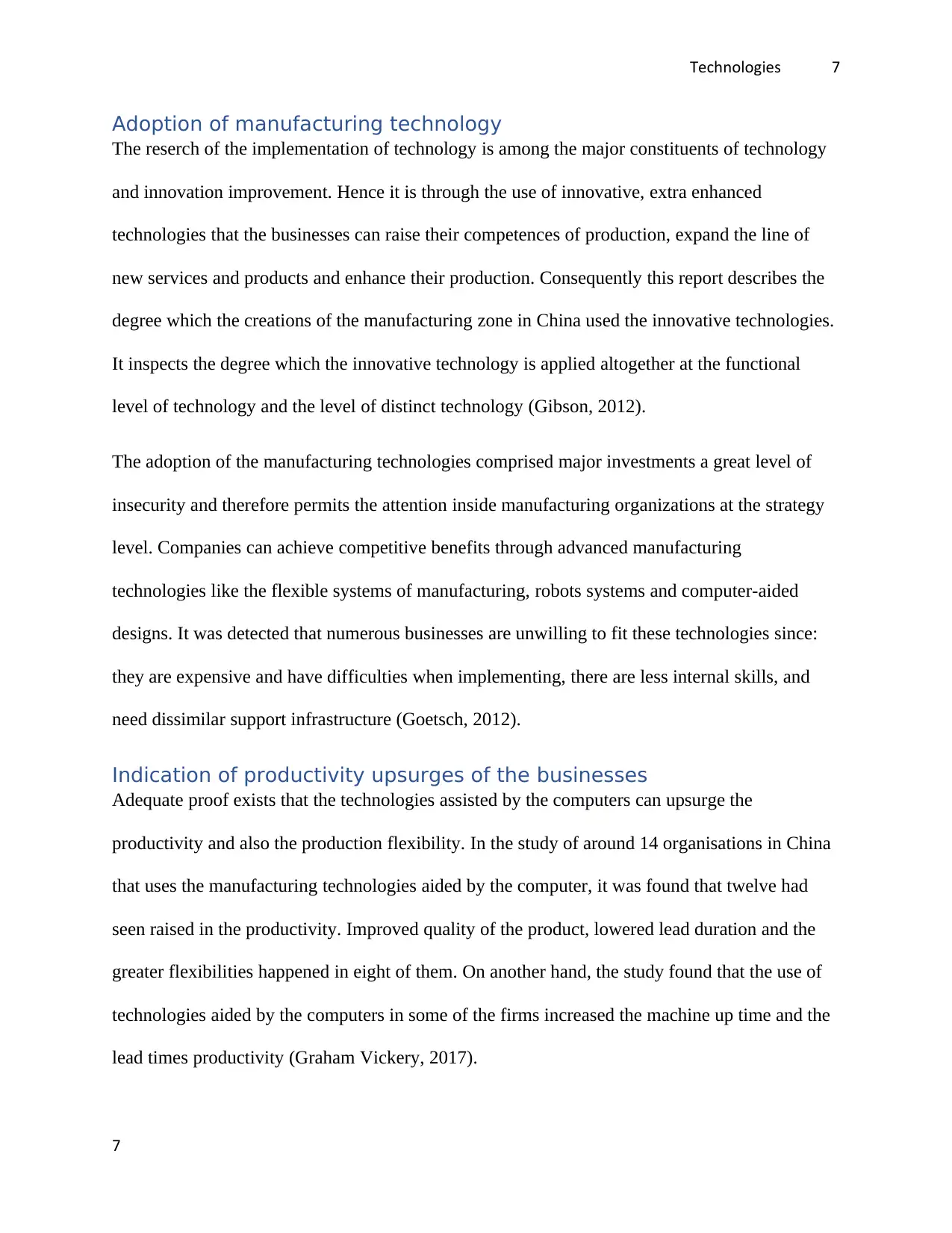
Technologies 7
Adoption of manufacturing technology
The reserch of the implementation of technology is among the major constituents of technology
and innovation improvement. Hence it is through the use of innovative, extra enhanced
technologies that the businesses can raise their competences of production, expand the line of
new services and products and enhance their production. Consequently this report describes the
degree which the creations of the manufacturing zone in China used the innovative technologies.
It inspects the degree which the innovative technology is applied altogether at the functional
level of technology and the level of distinct technology (Gibson, 2012).
The adoption of the manufacturing technologies comprised major investments a great level of
insecurity and therefore permits the attention inside manufacturing organizations at the strategy
level. Companies can achieve competitive benefits through advanced manufacturing
technologies like the flexible systems of manufacturing, robots systems and computer-aided
designs. It was detected that numerous businesses are unwilling to fit these technologies since:
they are expensive and have difficulties when implementing, there are less internal skills, and
need dissimilar support infrastructure (Goetsch, 2012).
Indication of productivity upsurges of the businesses
Adequate proof exists that the technologies assisted by the computers can upsurge the
productivity and also the production flexibility. In the study of around 14 organisations in China
that uses the manufacturing technologies aided by the computer, it was found that twelve had
seen raised in the productivity. Improved quality of the product, lowered lead duration and the
greater flexibilities happened in eight of them. On another hand, the study found that the use of
technologies aided by the computers in some of the firms increased the machine up time and the
lead times productivity (Graham Vickery, 2017).
7
Adoption of manufacturing technology
The reserch of the implementation of technology is among the major constituents of technology
and innovation improvement. Hence it is through the use of innovative, extra enhanced
technologies that the businesses can raise their competences of production, expand the line of
new services and products and enhance their production. Consequently this report describes the
degree which the creations of the manufacturing zone in China used the innovative technologies.
It inspects the degree which the innovative technology is applied altogether at the functional
level of technology and the level of distinct technology (Gibson, 2012).
The adoption of the manufacturing technologies comprised major investments a great level of
insecurity and therefore permits the attention inside manufacturing organizations at the strategy
level. Companies can achieve competitive benefits through advanced manufacturing
technologies like the flexible systems of manufacturing, robots systems and computer-aided
designs. It was detected that numerous businesses are unwilling to fit these technologies since:
they are expensive and have difficulties when implementing, there are less internal skills, and
need dissimilar support infrastructure (Goetsch, 2012).
Indication of productivity upsurges of the businesses
Adequate proof exists that the technologies assisted by the computers can upsurge the
productivity and also the production flexibility. In the study of around 14 organisations in China
that uses the manufacturing technologies aided by the computer, it was found that twelve had
seen raised in the productivity. Improved quality of the product, lowered lead duration and the
greater flexibilities happened in eight of them. On another hand, the study found that the use of
technologies aided by the computers in some of the firms increased the machine up time and the
lead times productivity (Graham Vickery, 2017).
7
Paraphrase This Document
Need a fresh take? Get an instant paraphrase of this document with our AI Paraphraser
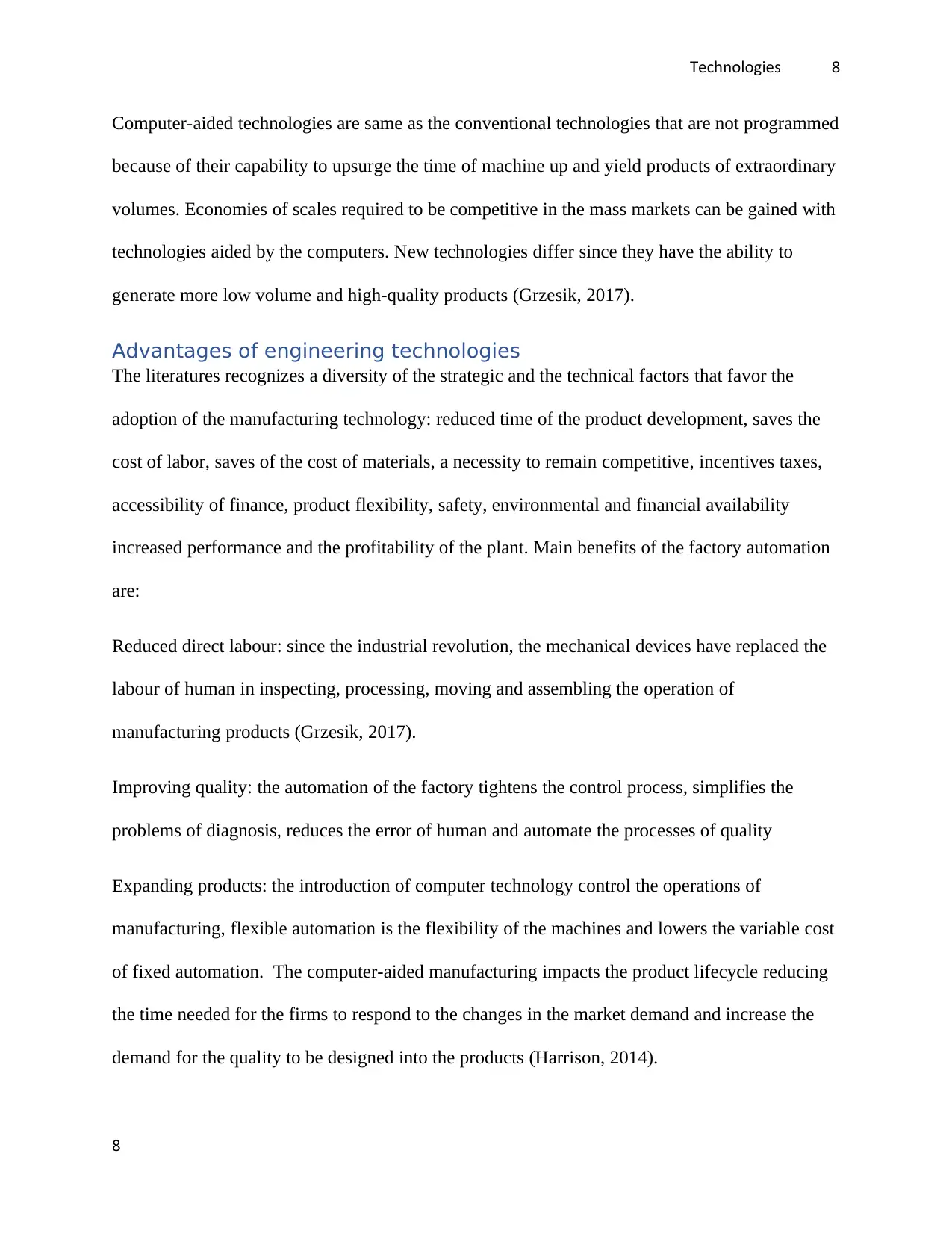
Technologies 8
Computer-aided technologies are same as the conventional technologies that are not programmed
because of their capability to upsurge the time of machine up and yield products of extraordinary
volumes. Economies of scales required to be competitive in the mass markets can be gained with
technologies aided by the computers. New technologies differ since they have the ability to
generate more low volume and high-quality products (Grzesik, 2017).
Advantages of engineering technologies
The literatures recognizes a diversity of the strategic and the technical factors that favor the
adoption of the manufacturing technology: reduced time of the product development, saves the
cost of labor, saves of the cost of materials, a necessity to remain competitive, incentives taxes,
accessibility of finance, product flexibility, safety, environmental and financial availability
increased performance and the profitability of the plant. Main benefits of the factory automation
are:
Reduced direct labour: since the industrial revolution, the mechanical devices have replaced the
labour of human in inspecting, processing, moving and assembling the operation of
manufacturing products (Grzesik, 2017).
Improving quality: the automation of the factory tightens the control process, simplifies the
problems of diagnosis, reduces the error of human and automate the processes of quality
Expanding products: the introduction of computer technology control the operations of
manufacturing, flexible automation is the flexibility of the machines and lowers the variable cost
of fixed automation. The computer-aided manufacturing impacts the product lifecycle reducing
the time needed for the firms to respond to the changes in the market demand and increase the
demand for the quality to be designed into the products (Harrison, 2014).
8
Computer-aided technologies are same as the conventional technologies that are not programmed
because of their capability to upsurge the time of machine up and yield products of extraordinary
volumes. Economies of scales required to be competitive in the mass markets can be gained with
technologies aided by the computers. New technologies differ since they have the ability to
generate more low volume and high-quality products (Grzesik, 2017).
Advantages of engineering technologies
The literatures recognizes a diversity of the strategic and the technical factors that favor the
adoption of the manufacturing technology: reduced time of the product development, saves the
cost of labor, saves of the cost of materials, a necessity to remain competitive, incentives taxes,
accessibility of finance, product flexibility, safety, environmental and financial availability
increased performance and the profitability of the plant. Main benefits of the factory automation
are:
Reduced direct labour: since the industrial revolution, the mechanical devices have replaced the
labour of human in inspecting, processing, moving and assembling the operation of
manufacturing products (Grzesik, 2017).
Improving quality: the automation of the factory tightens the control process, simplifies the
problems of diagnosis, reduces the error of human and automate the processes of quality
Expanding products: the introduction of computer technology control the operations of
manufacturing, flexible automation is the flexibility of the machines and lowers the variable cost
of fixed automation. The computer-aided manufacturing impacts the product lifecycle reducing
the time needed for the firms to respond to the changes in the market demand and increase the
demand for the quality to be designed into the products (Harrison, 2014).
8
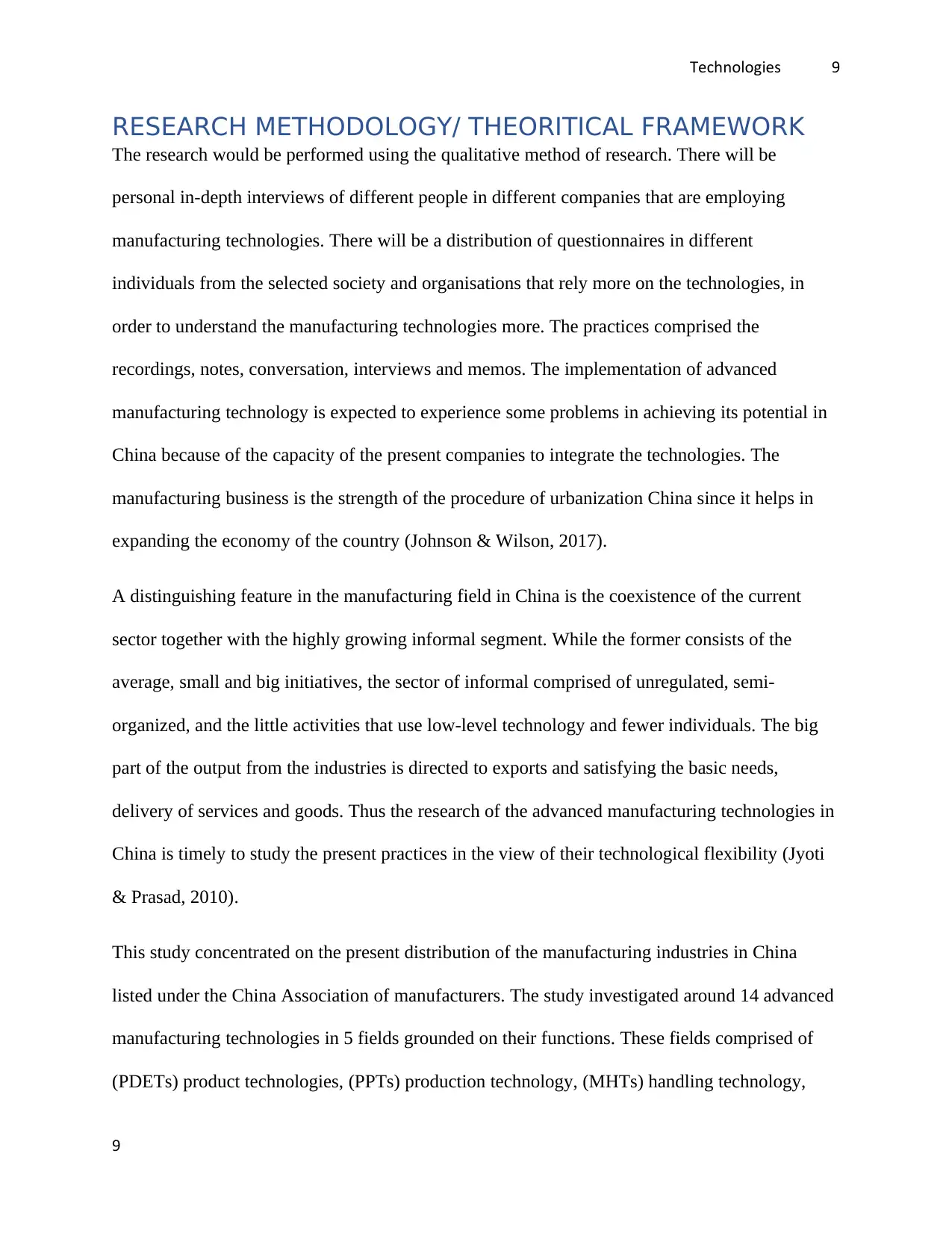
Technologies 9
RESEARCH METHODOLOGY/ THEORITICAL FRAMEWORK
The research would be performed using the qualitative method of research. There will be
personal in-depth interviews of different people in different companies that are employing
manufacturing technologies. There will be a distribution of questionnaires in different
individuals from the selected society and organisations that rely more on the technologies, in
order to understand the manufacturing technologies more. The practices comprised the
recordings, notes, conversation, interviews and memos. The implementation of advanced
manufacturing technology is expected to experience some problems in achieving its potential in
China because of the capacity of the present companies to integrate the technologies. The
manufacturing business is the strength of the procedure of urbanization China since it helps in
expanding the economy of the country (Johnson & Wilson, 2017).
A distinguishing feature in the manufacturing field in China is the coexistence of the current
sector together with the highly growing informal segment. While the former consists of the
average, small and big initiatives, the sector of informal comprised of unregulated, semi-
organized, and the little activities that use low-level technology and fewer individuals. The big
part of the output from the industries is directed to exports and satisfying the basic needs,
delivery of services and goods. Thus the research of the advanced manufacturing technologies in
China is timely to study the present practices in the view of their technological flexibility (Jyoti
& Prasad, 2010).
This study concentrated on the present distribution of the manufacturing industries in China
listed under the China Association of manufacturers. The study investigated around 14 advanced
manufacturing technologies in 5 fields grounded on their functions. These fields comprised of
(PDETs) product technologies, (PPTs) production technology, (MHTs) handling technology,
9
RESEARCH METHODOLOGY/ THEORITICAL FRAMEWORK
The research would be performed using the qualitative method of research. There will be
personal in-depth interviews of different people in different companies that are employing
manufacturing technologies. There will be a distribution of questionnaires in different
individuals from the selected society and organisations that rely more on the technologies, in
order to understand the manufacturing technologies more. The practices comprised the
recordings, notes, conversation, interviews and memos. The implementation of advanced
manufacturing technology is expected to experience some problems in achieving its potential in
China because of the capacity of the present companies to integrate the technologies. The
manufacturing business is the strength of the procedure of urbanization China since it helps in
expanding the economy of the country (Johnson & Wilson, 2017).
A distinguishing feature in the manufacturing field in China is the coexistence of the current
sector together with the highly growing informal segment. While the former consists of the
average, small and big initiatives, the sector of informal comprised of unregulated, semi-
organized, and the little activities that use low-level technology and fewer individuals. The big
part of the output from the industries is directed to exports and satisfying the basic needs,
delivery of services and goods. Thus the research of the advanced manufacturing technologies in
China is timely to study the present practices in the view of their technological flexibility (Jyoti
& Prasad, 2010).
This study concentrated on the present distribution of the manufacturing industries in China
listed under the China Association of manufacturers. The study investigated around 14 advanced
manufacturing technologies in 5 fields grounded on their functions. These fields comprised of
(PDETs) product technologies, (PPTs) production technology, (MHTs) handling technology,
9
⊘ This is a preview!⊘
Do you want full access?
Subscribe today to unlock all pages.

Trusted by 1+ million students worldwide
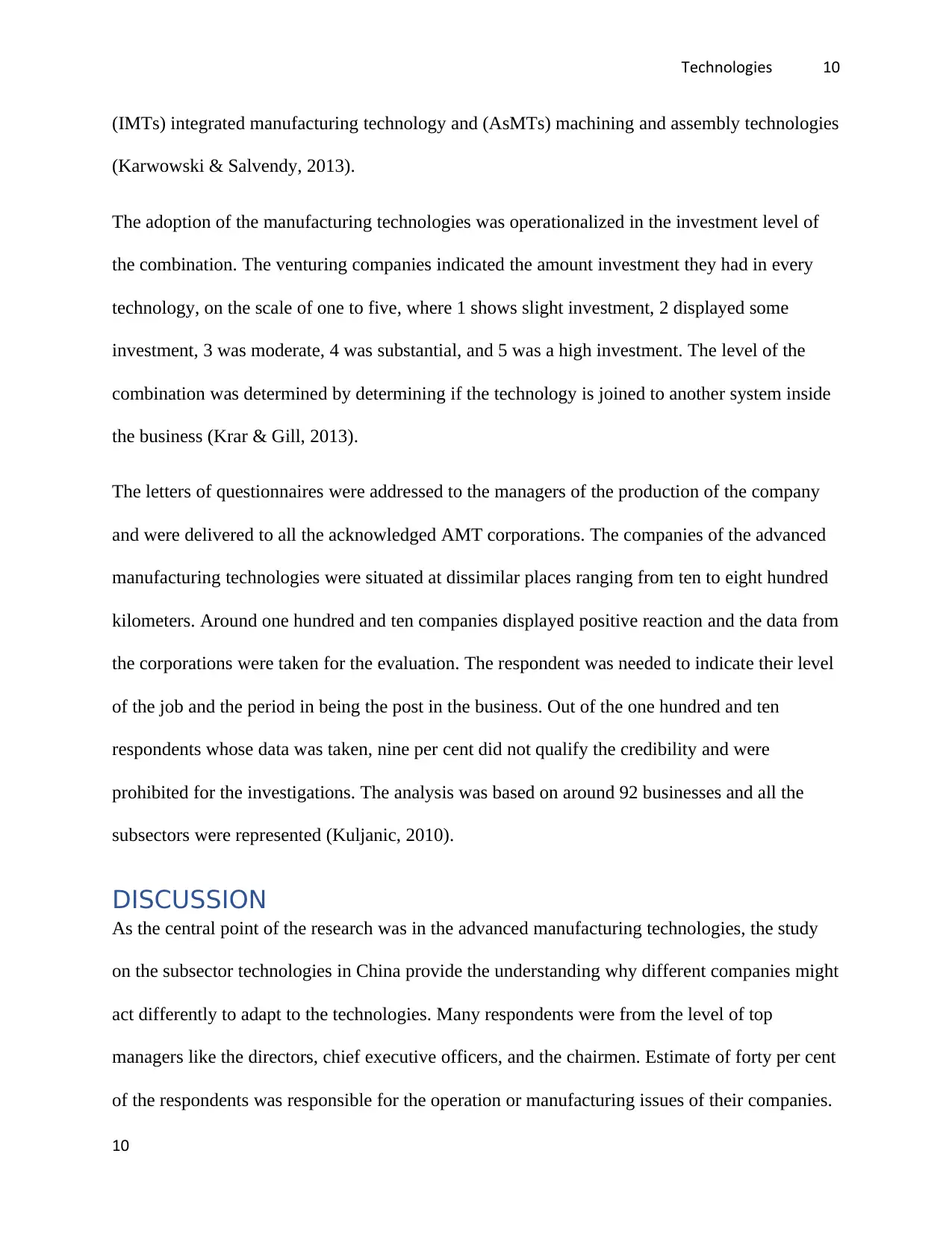
Technologies 10
(IMTs) integrated manufacturing technology and (AsMTs) machining and assembly technologies
(Karwowski & Salvendy, 2013).
The adoption of the manufacturing technologies was operationalized in the investment level of
the combination. The venturing companies indicated the amount investment they had in every
technology, on the scale of one to five, where 1 shows slight investment, 2 displayed some
investment, 3 was moderate, 4 was substantial, and 5 was a high investment. The level of the
combination was determined by determining if the technology is joined to another system inside
the business (Krar & Gill, 2013).
The letters of questionnaires were addressed to the managers of the production of the company
and were delivered to all the acknowledged AMT corporations. The companies of the advanced
manufacturing technologies were situated at dissimilar places ranging from ten to eight hundred
kilometers. Around one hundred and ten companies displayed positive reaction and the data from
the corporations were taken for the evaluation. The respondent was needed to indicate their level
of the job and the period in being the post in the business. Out of the one hundred and ten
respondents whose data was taken, nine per cent did not qualify the credibility and were
prohibited for the investigations. The analysis was based on around 92 businesses and all the
subsectors were represented (Kuljanic, 2010).
DISCUSSION
As the central point of the research was in the advanced manufacturing technologies, the study
on the subsector technologies in China provide the understanding why different companies might
act differently to adapt to the technologies. Many respondents were from the level of top
managers like the directors, chief executive officers, and the chairmen. Estimate of forty per cent
of the respondents was responsible for the operation or manufacturing issues of their companies.
10
(IMTs) integrated manufacturing technology and (AsMTs) machining and assembly technologies
(Karwowski & Salvendy, 2013).
The adoption of the manufacturing technologies was operationalized in the investment level of
the combination. The venturing companies indicated the amount investment they had in every
technology, on the scale of one to five, where 1 shows slight investment, 2 displayed some
investment, 3 was moderate, 4 was substantial, and 5 was a high investment. The level of the
combination was determined by determining if the technology is joined to another system inside
the business (Krar & Gill, 2013).
The letters of questionnaires were addressed to the managers of the production of the company
and were delivered to all the acknowledged AMT corporations. The companies of the advanced
manufacturing technologies were situated at dissimilar places ranging from ten to eight hundred
kilometers. Around one hundred and ten companies displayed positive reaction and the data from
the corporations were taken for the evaluation. The respondent was needed to indicate their level
of the job and the period in being the post in the business. Out of the one hundred and ten
respondents whose data was taken, nine per cent did not qualify the credibility and were
prohibited for the investigations. The analysis was based on around 92 businesses and all the
subsectors were represented (Kuljanic, 2010).
DISCUSSION
As the central point of the research was in the advanced manufacturing technologies, the study
on the subsector technologies in China provide the understanding why different companies might
act differently to adapt to the technologies. Many respondents were from the level of top
managers like the directors, chief executive officers, and the chairmen. Estimate of forty per cent
of the respondents was responsible for the operation or manufacturing issues of their companies.
10
Paraphrase This Document
Need a fresh take? Get an instant paraphrase of this document with our AI Paraphraser
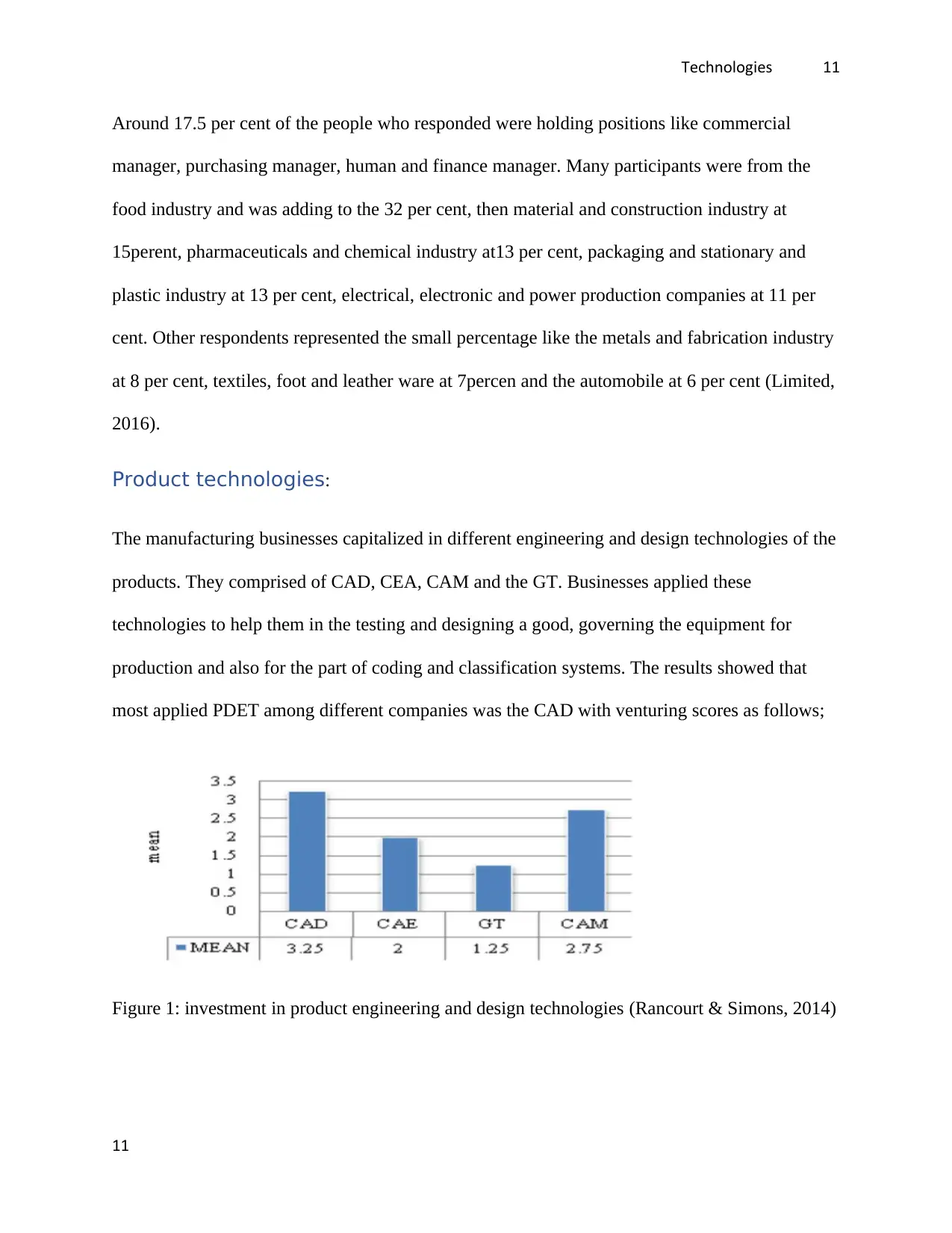
Technologies 11
Around 17.5 per cent of the people who responded were holding positions like commercial
manager, purchasing manager, human and finance manager. Many participants were from the
food industry and was adding to the 32 per cent, then material and construction industry at
15perent, pharmaceuticals and chemical industry at13 per cent, packaging and stationary and
plastic industry at 13 per cent, electrical, electronic and power production companies at 11 per
cent. Other respondents represented the small percentage like the metals and fabrication industry
at 8 per cent, textiles, foot and leather ware at 7percen and the automobile at 6 per cent (Limited,
2016).
Product technologies:
The manufacturing businesses capitalized in different engineering and design technologies of the
products. They comprised of CAD, CEA, CAM and the GT. Businesses applied these
technologies to help them in the testing and designing a good, governing the equipment for
production and also for the part of coding and classification systems. The results showed that
most applied PDET among different companies was the CAD with venturing scores as follows;
Figure 1: investment in product engineering and design technologies (Rancourt & Simons, 2014)
11
Around 17.5 per cent of the people who responded were holding positions like commercial
manager, purchasing manager, human and finance manager. Many participants were from the
food industry and was adding to the 32 per cent, then material and construction industry at
15perent, pharmaceuticals and chemical industry at13 per cent, packaging and stationary and
plastic industry at 13 per cent, electrical, electronic and power production companies at 11 per
cent. Other respondents represented the small percentage like the metals and fabrication industry
at 8 per cent, textiles, foot and leather ware at 7percen and the automobile at 6 per cent (Limited,
2016).
Product technologies:
The manufacturing businesses capitalized in different engineering and design technologies of the
products. They comprised of CAD, CEA, CAM and the GT. Businesses applied these
technologies to help them in the testing and designing a good, governing the equipment for
production and also for the part of coding and classification systems. The results showed that
most applied PDET among different companies was the CAD with venturing scores as follows;
Figure 1: investment in product engineering and design technologies (Rancourt & Simons, 2014)
11
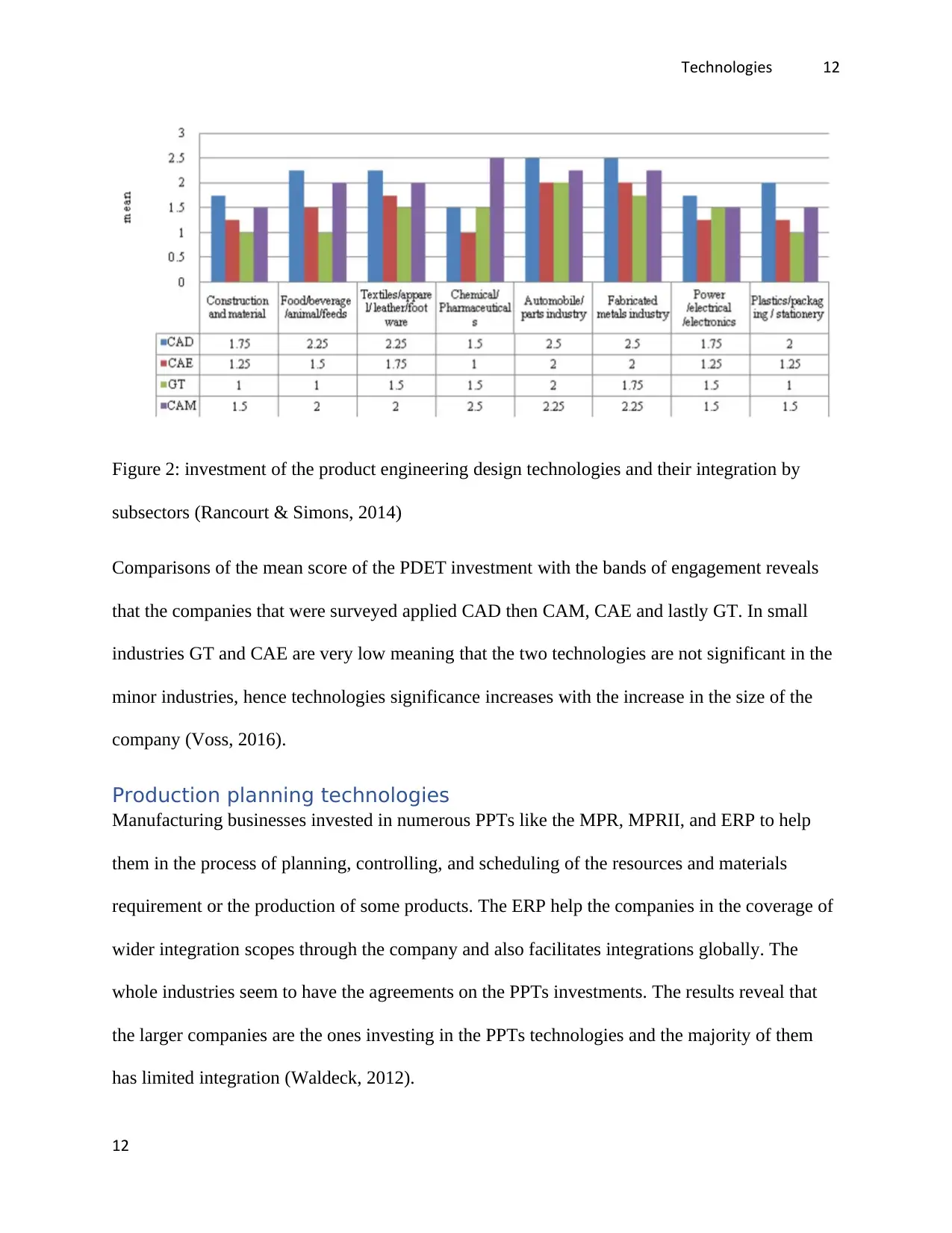
Technologies 12
Figure 2: investment of the product engineering design technologies and their integration by
subsectors (Rancourt & Simons, 2014)
Comparisons of the mean score of the PDET investment with the bands of engagement reveals
that the companies that were surveyed applied CAD then CAM, CAE and lastly GT. In small
industries GT and CAE are very low meaning that the two technologies are not significant in the
minor industries, hence technologies significance increases with the increase in the size of the
company (Voss, 2016).
Production planning technologies
Manufacturing businesses invested in numerous PPTs like the MPR, MPRII, and ERP to help
them in the process of planning, controlling, and scheduling of the resources and materials
requirement or the production of some products. The ERP help the companies in the coverage of
wider integration scopes through the company and also facilitates integrations globally. The
whole industries seem to have the agreements on the PPTs investments. The results reveal that
the larger companies are the ones investing in the PPTs technologies and the majority of them
has limited integration (Waldeck, 2012).
12
Figure 2: investment of the product engineering design technologies and their integration by
subsectors (Rancourt & Simons, 2014)
Comparisons of the mean score of the PDET investment with the bands of engagement reveals
that the companies that were surveyed applied CAD then CAM, CAE and lastly GT. In small
industries GT and CAE are very low meaning that the two technologies are not significant in the
minor industries, hence technologies significance increases with the increase in the size of the
company (Voss, 2016).
Production planning technologies
Manufacturing businesses invested in numerous PPTs like the MPR, MPRII, and ERP to help
them in the process of planning, controlling, and scheduling of the resources and materials
requirement or the production of some products. The ERP help the companies in the coverage of
wider integration scopes through the company and also facilitates integrations globally. The
whole industries seem to have the agreements on the PPTs investments. The results reveal that
the larger companies are the ones investing in the PPTs technologies and the majority of them
has limited integration (Waldeck, 2012).
12
⊘ This is a preview!⊘
Do you want full access?
Subscribe today to unlock all pages.

Trusted by 1+ million students worldwide
1 out of 19
Related Documents
Your All-in-One AI-Powered Toolkit for Academic Success.
+13062052269
info@desklib.com
Available 24*7 on WhatsApp / Email
![[object Object]](/_next/static/media/star-bottom.7253800d.svg)
Unlock your academic potential
Copyright © 2020–2025 A2Z Services. All Rights Reserved. Developed and managed by ZUCOL.





